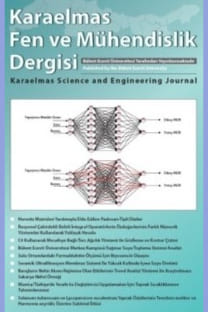Ultrasonik Ksantan Degradasyonuna Tuz Etkisinin İncelenmesi
Ksantan düşük maliyeti ve sulu çözeltilerde gösterdiği farklı fiziko kimyasal karakteristiklerinden dolayı ilaç, kozmetik ve gıda endüstrilerinde geniş uygulanabilirlik sunar. Bu çalışmada ksantanın ultrasonik degradasyonu NaCl çözeltilerinde incelenmiştir. NaCl konsantrasyonu 0.5-10 mM arasında seçilerek çözelti değiştirilmiş ve ultrases frekans-şiddeti, ksantan konsantrasyonu, sıcaklık sabit tutulmuştur. Degradasyon kinetiği viskozimetre ile izlenmiş ve çözeltideki NaCl konsantrasyonuna bağlı bulunmuştur
Anahtar Kelimeler:
Degradasyon, Ksantan, Ultrases, Viskozite
Investigation of the effect of NaCl on ultrasonic xanthan degradation
Xanthan presents wide applicability in pharmaceutical, cosmetic and food industries because of low cost and different physicochemical characteristics in aqueous solutions. In this study ultrasonic degradation of Xanthan is investigated in NaCl solutions. The solution is changed by varying NaCl concentration between 0.5-10 mM and ultrasound frequency-intensity, xanthan concentration, temperature kept constant. Degradation kinetics was monitored by viscometry and is found to depend on NaCl concentration in solution.
Keywords:
Ultrasound, Xanthan, Viscosity, Degradation,
___
- Akyüz, A., Çatalgil-Giz, H., Giz, A. 2008. Kinetics of ultrasonic polymer degradation: comparison of theoretical models with on-line data. Macromol. Chem. Phys., (209): 801-09.
- Akyüz, A., Çatalgil-Giz, H., Giz, A. 2009. Effect of solvent characteristics on the ultrasonic degradation of poly(vinylpyrrolidone) studied by on-line monitoring. Macromol. Chem. Phys., (210): 1331-1338.
- Akyüz, A. ,Çatalgil-Giz, H., Giz, A. 2008. Investigation of termination during ultrasonic depolymerization. Macromol. Sy., (275): 112-116.
- Akyüz, A. ,Kamer, O., Giz, A. 2008.Online Viscometric monitoring of ultrasonic sodium poly (styrene sulfonate) scission, J. Macromol. Sci. A,(50): 535-540.
- Brunchi, CE., Morariu, S., Bercea, M. 2014. Intrinsic viscosity and conformational parameters of xanthan in aqueous solutions: Salt addition effect. Colloids Surf. B, (122): 512-519.
- Casale, A., Porter, R. S., 1979. Polymer Stress Reactions. (pp 40). Academic Press, NY.
- Chemat, F., Khan, M. K., Huma, ZH. 2011. Applications of ultrasound in food technology: Processing, preservation and extraction. Ultrason. Sonochem., (18): 813-835.
- Chun, MS., Park, OO. 1994. On the intrinsic viscosity of anionic and nonionic rodlike polysaccharide solutions. Macromol. Chem. Phys., (195): 701-711.
- Demirdöven, A., Baysal, T. 2008. The use of ultrasound and combined technologies in food preservation, Food Rev. Int., (25):1-11.
- García-Ochoa, F., Santos, VE., Casas, JA., Gómez, E. 2000. Xanthan gum: production, recovery, and properties. Biotechnol. Adv., (18): 549-579.
- Kennedy, JF., Bradshaw, IJ. 1984. Production, properties and applications of xanthan, Prog. Ind. Microbiol., (19): 319-390.
- Li, P., Zeng, Y., Xie, Y., Li, X., Kang, Y., Wang, Y., Xie, T., Zhang, Y. 2016. Effect of pretreatment on the enzymatic hydrolysis of kitchen waste for xanthan production. Bioresour. Technol., (223): 84-90.
- Li, R., Feke, DL. 2015. Rheological and kinetic study of the ultrasonic degradation of xanthan gum in aqueous solutions. Food Chem., (172): 808-813.
- Milas, M., Rinaudo, M., Tinland, B. 1986. Comparative depolymerization of xanthan gum by ultrasonic and enzymic treatments. Rheological and structural properties. Carbohyd. Polym., (6): 95-107.
- Ogutu, FO., Mu, TH., Elahi, R., Zhang, M, Sun, HN. 2015. Ultrasonic modification of selected polysaccharides-Review. J. Food Process. Technol., (6): 1-8.
- Vega, ED., Vasquez, E., Diaz, JRA., Masuelli, MA. 2015. Influence of the ionic strength in the intrinsic viscosity of xanthan gum. An experimental review. JPBPC, (3): 12-18.
- Vijayalakshmi, SP., Madras, G. 2006. Effects of the pH, concentration, and solvents on the ultrasonic degradation of poly(vinyl alcohol). J. Appl. Polym. Sci., (100): 4888–4892.
- ISSN: 2146-4987
- Yayın Aralığı: Yılda 2 Sayı
- Başlangıç: 2011
- Yayıncı: ZONGULDAK BÜLENT ECEVİT ÜNİVERSİTESİ
Sayıdaki Diğer Makaleler
Telekomünikasyon Sektöründe Müşteri Ayrılma Tahmin Analizi Çalışmaları Derlemesi
Çok Yönlü Araç Takibi ve Sayımı Uygulaması
ŞENGÜL DOĞAN, GONCA ÖZMEN KOCA, Hicran YILMAZ
An Investigation on the Quality of Natural Spring Waters in Zonguldak Province (Turkey)
Hüseyin AYTEKİN, Nazmi BAYRAKTAROĞLU
Naringeninden Elde Edilen Polimer Schiff Bazı Ligandı ve Komplekslerinin DNA Etkileşimleri
Dolgu Duvarlı Betonarme Çerçeveli Binalarda Hakim Periyodun Belirlenmesi
Türkiye’de 1974-2016 Yıllarında İş Sağlığı ve Güvenliği Alanında Yapılan Lisansüstü Tezlerin Profili
